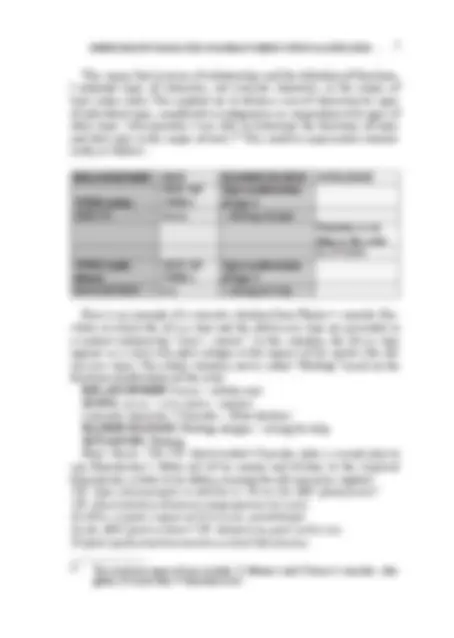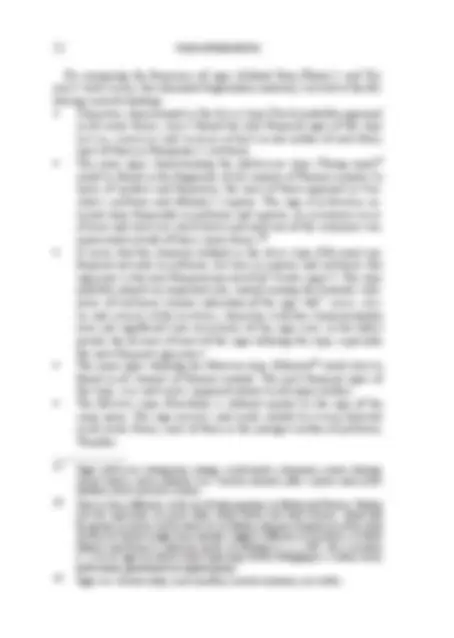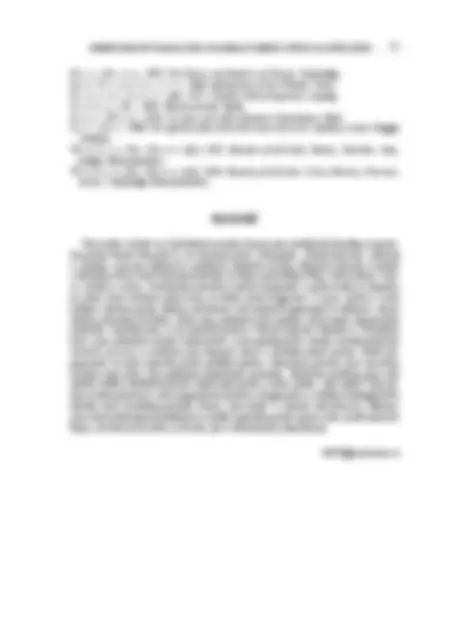Download New Classification of Roman Comedy Characters: A Study on Contrasts and Correspondences and more Study notes Theatre in PDF only on Docsity!
GRAECO-LATINA BRUNENSIA 19, 2014, 2
(MASARYK UNIVERSITY, BRNO)ŠÁRKA HURBÁNKOVÁ
REPERTOIRE OF CHARACTERS IN ROMAN COMEDY: NEW CLASSIFICATION APPROACHES
What is Roman comedy? Which ancient theatre forms can be included under this term? How to classify the characters of texts of Plautus’s and Terence’s palliatae palliatae , togatae available on the one hand, and, atellanae and mimi , having mostly complete palliatae , togatae , atellanae of classifying a tion. Complete texts were analyzed in terms of contrasts and correspondences, allowing and mimi repertoire of characters in Roman comedy which I preserved only fragmentally on the other? This study presents a used in my disserta method- me to determine the correspondences and similarities not only among dramatic characters or types separately in Plautus’s and separately in Terence’s comedies, but also point out certain correspondences and similarities in the entire historical corpus of texts mapping a specific and their roles in the corpus of texts, which, at the same time, provided me with a of typical traits of various types of characters, manifested in antagonism or cooperation period or genre. Therefore, I determined structural functions of individual summary types with other types of characters. I the characters from fragments, using clear arrangement into contingency tables. Due to this comparison and other partial findings compared this set of “words-signs” with words describing enabled by this method and tools used, it was possible to describe, at least partially, not only a but also compare them with each other and determine how the man comedy changed diachronically. repertoire of characters of individual comic forms, “dramatis personae” of Ro- Key words: trasts and correspondences, Ancient theatre, structural functions, comic situation, type and typification, stock characters, Roman comedy, atellana, personae oscae palliata, , qui pro quo, togata, mimus, disguise, repertoire of characters, con dramatis personae -
under this term? If we want to define the concept of “Roman comedy” ob jectively, we especially come across these two pitfalls: the inconsistency^ What is Roman comedy? Which ancient theatre forms can be included-
of terms which were already in ancient times used to define various theatre forms, and the accessibility of the material under study that is nowadays available.
4 In the 20th century, classical philologists analyzed in detail preservedŠÁRKA HURBÁNKOVÁ
Plautus’s and Terence’s texts, which have become representatives of Ro man comedy. In fact, these texts represent only one of the comic theatre forms with Latin texts which were performed on the territory of ancient-
Rome. adapted form (characters and settings remain Greek), while atellana Fabula palliata, and mimi were born right in the Italic environment (as for Latin inspired by the new Attic comedy, was a fabula togata rather,
mimus fortunately, Lack of material, Italic character and, in the case of, we need to consider the possible influence of Greek togatae , atellanae and mimi have survived only in fragments. mimi and perhaps also mimus ). Un-
atellanae ary one condemned these three comic forms to be examined mostly sepa rately as less important., the prevalence of the improvisational component over the liter--
scientific research, but none of these studies have applied a ysis of structural functions and relationships to the dramatic characters of^ Plautus’s and Terence’s^ palliatae^ have been the subject of a concrete anal^ number of-
these texts. mostly discussed only in relevant editions and a published in the 20th century.^1 Fragments of palliatae 2 Nonetheless, there is no study available, try, togatae , atellanae few separate studies were and mimi have been-
ing to compare the characters of all four Roman comic forms based on their character traits observable even in the fragmented material, although there have been some efforts recently to classify Roman dramatic genres within
a tation and offer a broader context – as a The main aim of this study is to present a new method to classify the characters of Roman comedy. whole influenced by various factors. method that I used in my disser^3 - 4
(^12) The characters (1973: 354–393),They mostly describe one comic variant, but there are also some which try to compare certain of Plautus’s and Terence’s D uCkworth (1952: 236–268), palliatae K are discussed e.g. in olář (1923: 125–132). D ella Corte 3 similar phenomena within these variants. E.g.k witharaka togatae SiS (2005) offers a and atellanae. Unfortunately, he does not include fragments of Latin linguistic analysis of Terence’s comedies and compares them^ GuarDì^ (1978: 37–45),^ Svelo^ (1980). mimi in the linguistic and stylistic analysis. dramatic genres of the Republican Rome. The publication adheres to the older terminol ogy and uses the term comoedia to refer only to Manuwal D palliatae (2011) describes authors, works and, yet its main contribution is- 4 that it does not focus only on the surviving texts, but also tries to give evidence of all the^ dramatic genres of theatre and their authors of the Republican Rome.This dissertation (hurbánková, 2012) aims to describe and compare a repertoire of characters of all theatre variants of Roman comedy, on the basis of findings about characters obtained from complete texts (corpus of Plautus’s and Terence’s comedies), as well as incomplete texts (fragments of palliatae , togatae , atellanae and mimi ). It also seeks to shed light on the issue of the genre system of Roman comedy and offer a hypothesis how the repertoire of its dramatic characters changed in time.
6 1. The analysis of contrasts and correspondences allows me to determineŠÁRKA HURBÁNKOVÁ
correspondences and similarities not only among dramatic characters separately in Plautus’s and separately in Terence’s comedies; it can also suggest certain correspondences and similarities in the entire his-
2. torical corpus of texts mapping aThe definition of structural functions in drama is determined by a curring role in the text corpus.^ certain period or genre.^10 re-
atively young: they started to be developed in the middle of the last centu ry.^ Methods of theatre semiotics analyzing characters and situations are rel 11 J. A. G reiMaS (1966) borrowed binary oppositional categories from--
structural semantics applied in linguistics and used them in literature. He was inspired by a theorist E. Souriau and introduced the term “actant” and “actantial role” Russian thinker V. J. propp (1968) and a French theatre
into literature. In drama, actant actually is the action of an acting charac ter, that is, a attribute a certain role to characters within the whole work or corpus of function according to propp (1968: 25). These functions then-
texts. rizing the structure of drama to actants and the characterization of charac ters only by actantial roles, and suggested understanding all expressions of^12 P. haMon (1977: 124–125) saw limitations of the analysis summa--
a reflected as a value of a character in situations as a character. According to him, the complex nature of a number of distinctive features, defining the importance and blank sign or a moving morpheme, which is character is
then influenced by several factors associated under this sign. acters is subject to typification: dramatic characters are defined by certain It should be noted that the repertoire of Plautus’s and Terence’s char^13 -
types that are superior to concrete characters. 10 lukeš (1978: 184–185) argues that valuable findings can be obtained by conducting^14
a individual works, and adds that also mechanism and stereotyping of best practices apply especially in comedy (already in the new Attic comedy and Plautus’s comedy). content analysis of the dramatic personnel of the entire text corpora, not only of 1112 For more on the analysis, seeInformation on the development of theatre semiotics is taken fromAccording to levý (1971: 128), a^ pfiSter conflict begins in epic poetry and drama when^ (1991: 166–170). elaM (2002). a and therefore represents a characters of a character assumes its role. A given social whole or literary work. structural function within the entire structure (network) of role can be performed by figures of various characters (^1314) For more on the factors defining a seepfi (^) SeterlaM (1991: 180): “If the type is divorced from individual qualities so that it can (2002: 119–120). detailed character of a figure according to Hamon, be used to represent some universal or typical supra-individual quality, the intention underlying a unique and contingent.” figure conceived as an individual is to bring out the features that are
REPERTOIRE OF CHARACTERS IN ROMAN COMEDY: NEW CLASSIFICATION …^7
I texts under study. This enabled me to obtain a analyzed types of characters, not concrete characters, in the corpus of^ This means that in terms of relationships and the definition of functions, sum of characteristic signs
of individual types, manifested in antagonism or cooperation with signs of other types. Subsequently, I and their roles in the corpus of texts. was able to determine the functions of types 15 This could be represented schemat-
ically, as follows: RELATIONSHIP SIGN MANIFESTATION SITUATION
TYPE1 (who) SERVUS^ SIGN OF TYPE 1 Servus^ Sign manifestation of type 1 – Plotting intrigue Function accor-
TYPE2 (with^ ding to the actor^ PLOTTING
whom) ADULESCENS^ SIGN OF TYPE 2 erus^ Sign manifestation of type 2 – Asking for help
chides a contrast relationship “slave – master”. In this situation, the^ Here is an example of a in which the Servus^ concrete situation from Plautus’s comedytype and the Adulescens type are presented in Servus^ Bac type -
appears as a ulescens function-manifestation of the actor: type). The whole situation can be called “Plotting” based on the slave who plots intrigue at the request of his master (the Ad-
RELATIONSHIP: SIGNS: (concrete characters: Chrysalus – Mnesilochus) servus – erus Servus – Adulescens (slave – master)
MANIFESTATION: SITUATION: Plaut. Bacch. 728–753: Quick-witted Chrysalus plots a Plotting Plotting intrigue – asking for help second plan to
con Mnesilochus’s father out of his money and dictates to the surprised Mnesilochus a CH. Cape stilum propere et tabellas tu as tibi. MN. Quid postea? letter to his father, warning the old man to be vigilant:
CH. Quod iubeboscribitoistic.namproptereauolo Scribere, ut pater cognoscat literas, quandolegat. Scribe. MN. Quid scribam? CH. Salutem tuo patri uerbis tuis.
PI.Quid sipotiusmorbum mortem scribat?ideritrectius. 15 The examined corpus of texts includes 21 Plautus’s and 6 Terence’s comedies. Alto-
gether, it is more than 27 thousand verses.
REPERTOIRE OF CHARACTERS IN ROMAN COMEDY: NEW CLASSIFICATION …^9
types, the most frequent actors of structural functions of the type, which mostly appear in a in contrast to the social relation “ relation to the servus – erus Adulescens ” (slave – master). Examining type (Young man) Servus (Slave)
Plautus’s and Terence’s comedies separately, we can see that both authors employ these types with similar frequency in various situations, but they differ in the type which takes the leading role: while in Plautus, the leading
actor is the man). In addition, further characteristics of both types (summaries of signs and manifestations of types in situations) very between the two authors: e.g. Servus type (Slave), in Terence it is the Adulescens type (Young
“Terence’s sons” via a father only in Terence’s palliatae; plotting prostitute can be found only in mediator; a^18 lustful father^ try to deceive their father directly, “Plautus’s sons” only 19 appears only in Plautus’s palliatae, fooled
Plautus, while insisting prostitute only in Terence; angry wife appeared only in Plautus, while blamed wife, often wrongly, in Terence; only “Plau tus’s parasites” deceive, but also help, “Terence’s parasites” mainly threat--
en, etc. Generally, based on the distinguishing features of gender, social status, generational and kinship affiliation, which resulted from contrasts and correspondences among dramatic characters of the examined corpus of
texts, we could divide characters into masters, servants and relatives, with a category of men and women superior to them. The question how to apply the obtained findings to the fragments remains. 20
The acquired signs are actually substantives denoting a zation of types in the surviving texts. In the previous analysis, I “words-signs” for each type, which can be compared with words describ specific characteri got a set of--
ing characters in the fragments. describe, at least partially, not only a comic forms, but also compare them with each other and determine how the^21 Hypothetically, it would be possible to repertoire of characters of individual
“dramatis personae” 18 The sign filius (son) is one of the main signs of the of Roman comedy changed diachronically. Adulescens (Young man) type.^22
(^1920) The signPfister (1991: 167) defines three suprahistorically relevant distinguishing features: gender, social, generation. pater (father) is one of the main signs of the Senex (Old man) type. (^21) For example, the most often intrigues, deceives, reproaches, makes fun, plots and teases somebody in situations, is characterized by the following signs: Servus type , which is the most frequent actor of functions and servus (slave), conservus (co- slave), (teacher), (master). In Terence, this type was defined only by the signs amicus atriensis (friend), (manager) and occasionally by signs rusticus (rural), urbanus (urban), amator patronus servus (lover), and(patron) and conservus paedagogus erus , the 22 others appeared exclusively in Plautus’s slaves.According to formed by this personnel)…”, therefore, “it historicizes with this personnel, or be lukeš (1987: 185), “a genre forms its dramatic personnel (and is-
10 When selecting fractions and titles of the surviving fragments of RomanŠÁRKA HURBÁNKOVÁ
comic forms, I istic features, i.e. personality traits, whether congenital or acquired, wider family relations, names and occupations. focused on words describing characters and their character 23 -
tus’s and Terence’s comedies with the “words-signs” from fragmented texts of authors of all comic variants, which have been preserved the best: Gnae^ Therefore, I^ compared the signs of types defined by the analysis of Plau--
us Naevius, Caecilius Statius, Sextus Turpilius, Titinius, Lucius Afranius, Titus Quinctius Atta, Lucius Pomponius Bononiensis, Novius, Decimus Laberius and Publilius Syrus.
ly of three authors of Turpilius), we can confirm that the repertoire of characters of^ By comparing these findings with the surviving fragmented texts main palliatae from various periods (Naevius, Caecilius, palliatae did-
not differ significantly and that the older authors were inspired by Greek models at least when naming their texts according to their protagonists, while the younger authors could also influence each other. My analysis
demonstrates the presence of at least one “word-sign” defining the main type of all authors, the occurrence of similar “words-signs” characterizing the relationships and character traits and names of the titles of palliatae of
younger authors similar to those of Plautus’s and Terence’s female characters speak more on the stage; they were also more often pro It seems that the authors of togatae (Titinius, Afranius, Atta) let their palliatae. -
tagonists of their pieces than in other comic forms: in fragments and titles of forms with feminine endings. When comparing “words-signs” with find togatae I noticed a larger number of substantives, adjectives and verb-
comes impediment to development as anachronistic, and as such, it must either perish or be the subject of innovation, which is always the process of transformation of its dramatic personnel”. In the analysis, I used the so-called “contingency (frequency) tables” when searching for the frequency of words and verses in Plautus’s and Ter ence’s texts, clarifying mutual relations between two variable signs. For more on con tingency tables, see henDl (2006: 307, 311–317, 485–489). This tool significantly-- helped me sort the material, assess the frequency of words as well as “words-signs” in various dependencies, define relationships, i.e. in other words, examine the material from multiple perspectives. (^23) Having selected texts for my study, I palliatae lanae , and 31 titles and 50 verses of, 44 titles and around 230 verses of mimus worked with 73 titles and around 200 verses of. All selected fractions and titles could be togatae , 70 titles and 60 verses of atel- fully classified into four working sections, which I of characters,” “Family relations,” “Proper names, nationalities, mythical figures and gods,” and “Occupations and crafts.” Titles and fragments were selected from these called “Features and descriptions editions: ‒ togata , rfyraChlewSSinettiSka (1967) ‒ (1971), w atellana arMin,G btononaria (1935, 1936) ‒ (1965) ‒ mimus palliata. , lópez (1983)
12 By comparing the frequency of signs (defined from Plautus’s and TerŠÁRKA HURBÁNKOVÁ -
ence’s texts) across the examined fragmentary material, I lowing concrete findings: • Characters characterized as the Servus type (Slave) probably appeared arrived at the fol-
in all comic forms, since I ( most of them in Pomponius’s servus , conservus and rusticus found the most frequent signs of this type atellanae ) at least in one author of each form,.
- The main signs characterizing the could be found in the fragments of all variants of Roman comedy. In terms of number and frequency, the most of them appeared in Cae Adulescens type (Young man)^27 -
cilius’s curred more frequently in ellanae palliatae and mimi and Afranius’swas much lower and only one of the synonyms was palliatae togatae and togatae. The sign, its occurrence in erus/dominus oc at - -
- represented in both of these comic forms.It seems that the character defined as the frequent not only in palliatae , but also in^28 Senextogatae type (Old man) was and atellanae (the
sign probably played an important role, mainly among the dramatic char acters of pater atellanae is the most frequent one out of all “words-signs”). This type (various indication of the sign “old”: senex , vetu - -
lus were not significant (rare occurrence of the sign period; the absence of most of the signs defining this type, especially and senica ), while in mimus , characters with this characterization senex in the oldest
- the most frequent signThe main signs defining the found in all variants of Roman comedy. The most frequent signs of^ pater ). Matrona type (Matron)^29 could also be
- this type,The same name. The sign Meretrix^ uxor type (Prostitute) is defined mainly by the sign of theand^ mater meretrix , appeared almost in all major authors. and words related to it were detected
in all comic forms, most of them in the youngest author of Turpilius. palliatae ,
(^27) Signs amator (brother), adulescens (lover), frater patruelis amicus (young man; young), (friend), (cousin) erus / dominus. condiscipulus (master), (classmate), filius / gnatus amans (son), (loving), frater (^28) There is also a uses the expression the greater occurrence of the word difference in the use of both synonyms in Plautus and Terence: Plautus erus more often, while Terence the word erus in Plautus and more frequent use of the word dominus. About half dominus Plautus’s and Terence’s characters speak. According to is “a set of signs by which verbal expression reveals belonging to a by Terence might, in my opinion, suggest a difference in sociolects, in which lukeš (1987: 66), a certain social, sociolect 29 professional, generational or regional group.”Signs era / domina (lady), mater (mother), matrona (matron), uxor (wife).
REPERTOIRE OF CHARACTERS IN ROMAN COMEDY: NEW CLASSIFICATION …^13
- The soror authors, the sign Virgo , virgo type (Young maiden) is defined by the signs. I found the sign of the same name, filia/gnata cannot be found in mimus virgo, , while the sign (^) in all major filia/gnata , -^ soror Other types characterized mainly by the signs of the same name did not have a^ in the fragments of high incidence: signs of the^ palliatae. Ancilla type (Maid) could be
found sporadically in Titinius’s and Afranius’s palliata togatae , signs of theand in one Laberius’s Parasitus type (Parasite) a mimus , signs of the togatae few times in Leno and Caecilius’s type (Man palliatae ,
running the brothel) sporadically in Turpilius’s gata in one Pomponius’s and Pomponius’s atellana atellana , signs of the, signs of the Cocus Miles palliata type (Cook) once in type (Soldier) only, Titinius’s to-
Naevius’s Lena signs of the type (Woman running the brothel) in one Trabea’s palliata Piscator , Titinius’s type (Fisherman) once in Pomponius’s togata , Laberius’s mimus , signs of the palliata atellana , and
- and Laberius’sCharacters defined according to the typology in Plautus’s and Ter ence’s texts as^ mimusMatrona. (sign uxor, mater ), Servus (sign servus ), Ad - -
ulescens probably appeared frequently in all forms of Roman comedy, since, in addition to general substantives, the words denoting their characteris (sign amicus ), Meretrix (sign meretrix ) and Virgo (sign virgo )-
In conclusion, we can determine how the repertoire of characters in Ro^ tic features occurred in fragments and titles of all comic forms most^ frequently.^30 -
man comedy could change diachronically. First, its distinctive feature proba bly was typification, which attributed typical features to characters: character types had similar characteristics in palliatae and togatae , although female-
roles also occupied a Later, the comic force of typifying appeared also in atellanae, but the types already had concrete typical names in these texts: stock characters significant position among the characters of togatae“perso-.
nae oscae” features of people from the poorest classes, reflecting the Italic environment from which they emerged. The comic effect in could associate under each name comic character and physical atellanae may have been
achieved by widely in Plautus’s play an important role: types defined using Plautus’s and Terence’s texts in qui pro quo palliatae and disguise, which were dramatic resources used. It seems that typification eventually ceases to
mimi Characters in apparently are not important, as we can see very few similarities there. mimi could be the closest to the common people of atellanae :
(^30) The overall total for each of these signs is 10 and more. These words can be found in greater numbers also in the texts of Plautus’s and Terence’s palliatae.
pfiSterREPERTOIRE OF CHARACTERS IN ROMAN COMEDY: NEW CLASSIFICATION …, M anfreD. 1991. The Theory and Analysis of Drama. Cambridge.^15
p r sropptehlíyChlew , (^) KvoválSAkadimir , ,e lvuA (^) D.J AK1993.oviovlevičCa Římské [ed.]. 1971.. 1968. divadlo. MorphologyTurpilii comici fragmenta. Praha. of the Folktale. Leipzig. Texas. s Souri velo Calabria.A. ua ,D éeletienne. 1980.. 1950. Un capitolo nella storia del comico del sesso: Atellane e mimi. Les deus cent mille situations dramatiques. Paris. Reggio w war bridge (Massachusetts).arMMininGGtonton,, (^) eeririCC hherberterbert [ed.]. 1936.[ed.]. 1935. Remains of old Latin: Livius, Naevius, Pacuvius,Remains of old Latin: Ennius, Caecilius. Cam- Accius. Cambridge (Massachusetts).
Tato studie si klade za cíl představit metodu, kterou jsem použila při klasifikaci reperto^ RESUMÉ -
áru postav římské komedie ve své disertační práci. Pod pojem „římská komedie“ zahrnuji v s latinskými texty, které byly provozovány nasouladu s pracemi některých soudobých badatelů všechny divadelní komické varianty území starověkého Říma, tedy palliatu, toga- tu, atellanu na můžeme zkoumat pouze zlomky, dochované z jedné straně většinou úplné texty, na a mimus. Dochovaný materiál je značně různorodý: z druhé straně fragmenty. Z děl antických gramatiků a palliat togat (^) vzdělanců. Abychmáme k, atellan dispozici a mimů získala relevantní výsledky, chtěla jsem podrobit určité analýze větší vzorek zkoumaného materiálu. Zaměřila jsem se na texty jsem podrobila analýze kontrastních a repertoár postav v korespondenčních vztahů charakterizujících římské komedii: Plautovy a Terentiovy dramatis personas pomenout, že tento repertoár postav podléhá typizaci: dramatické postavy jsou vymezeny určitými typy, které jsou nadřazeny konkrétním postavám. Předešlou analýzou jsem tedy a rozebrala jsem komické situace z hlediska funkcí postav. Nutno při- získala souhrn charakteristických znaků typů postav a tom možné porovnat se slovy popisujícími postavy z tabulek, které umožňují posoudit četnost „slov-znaků“ v fragmentů (s tento soubor „slov-znaků“ bylo po různých závislostech). Nakonec využitím kontingenčních- jsem tedy mohla popsat podobnosti a formy, ale také mezi sebou a určit tak, jak se diachronicky obměňovaly. rozdíly repertoáru postav nejen v rámci jedné komické 40056@mail.muni.cz
























